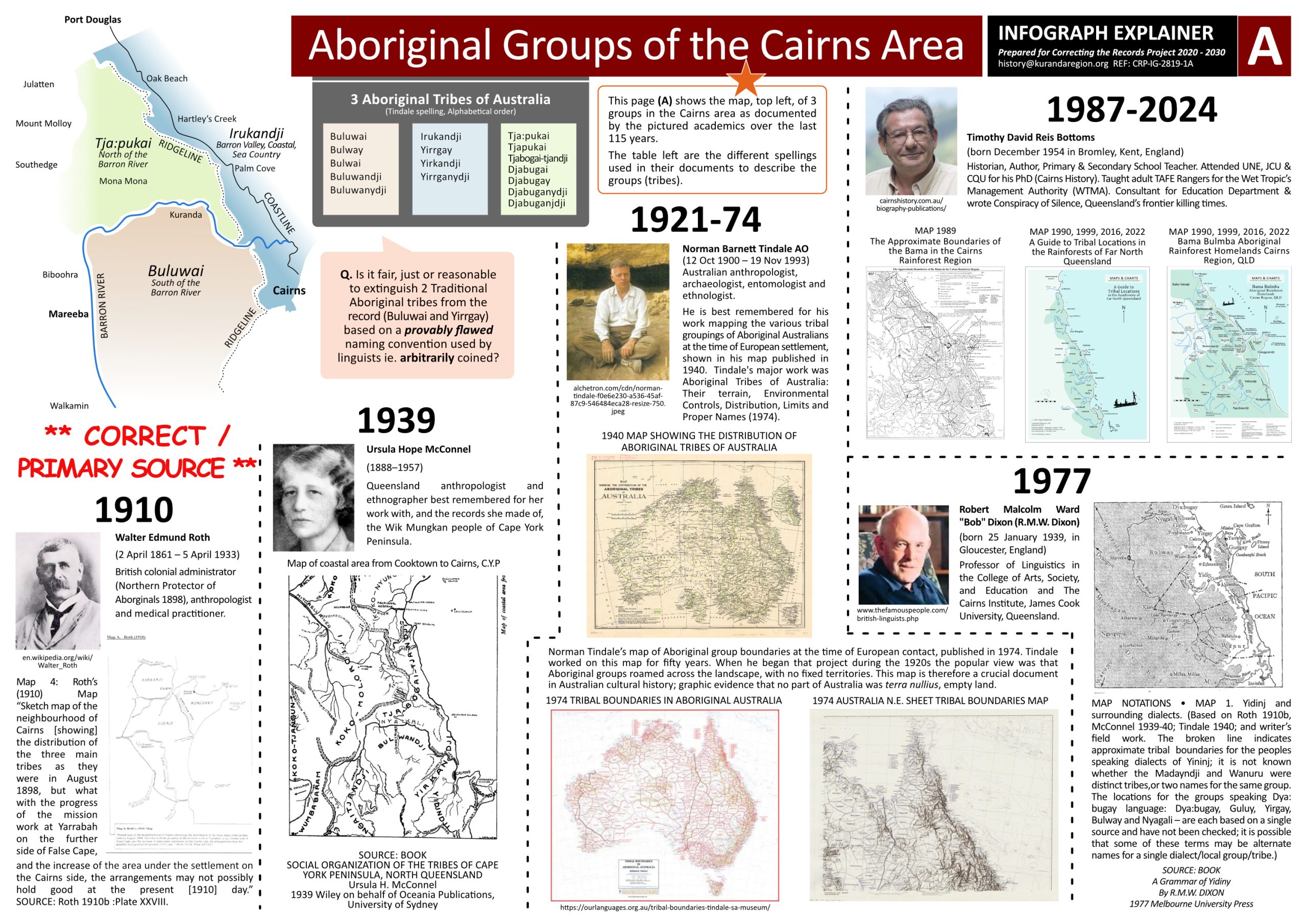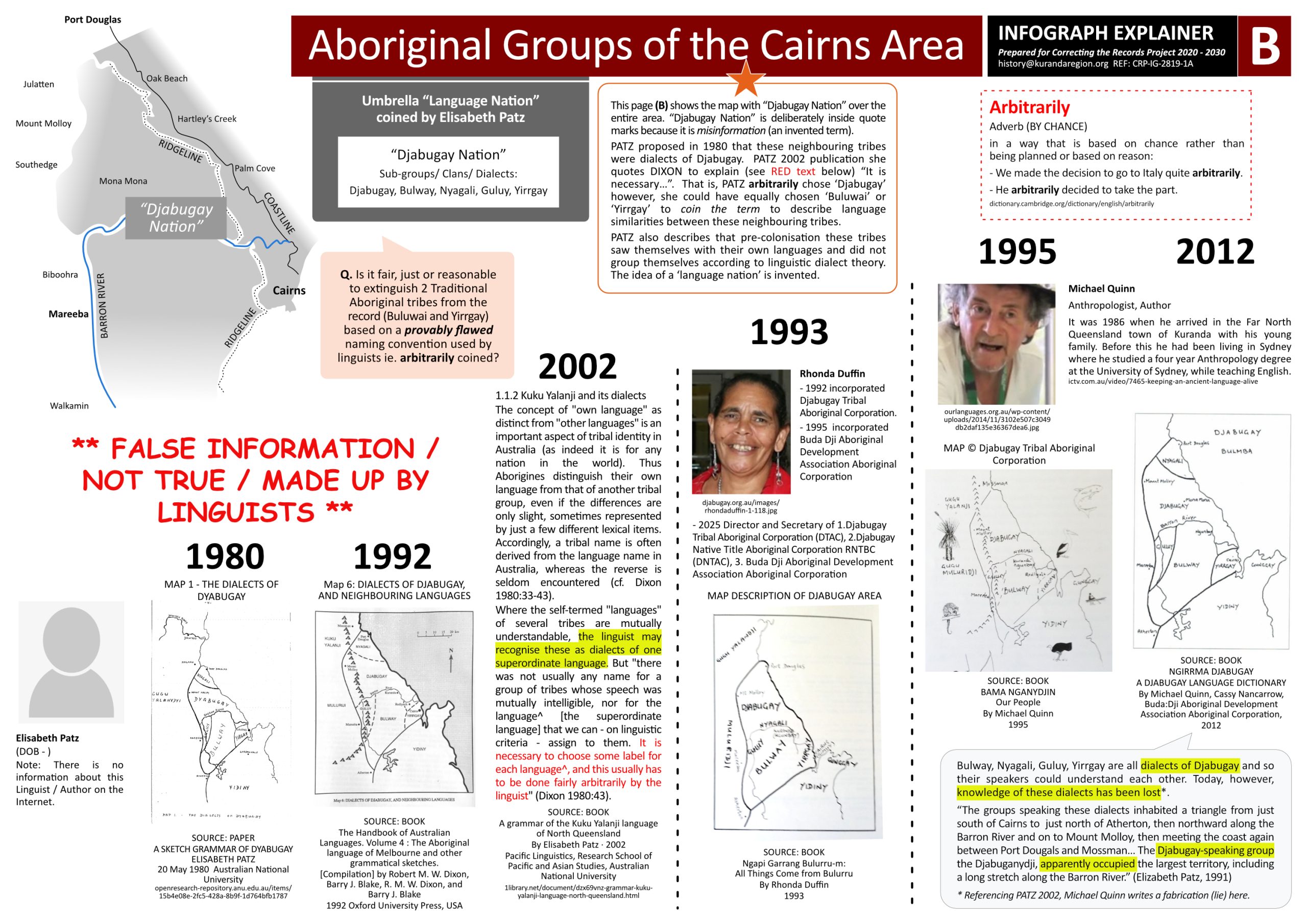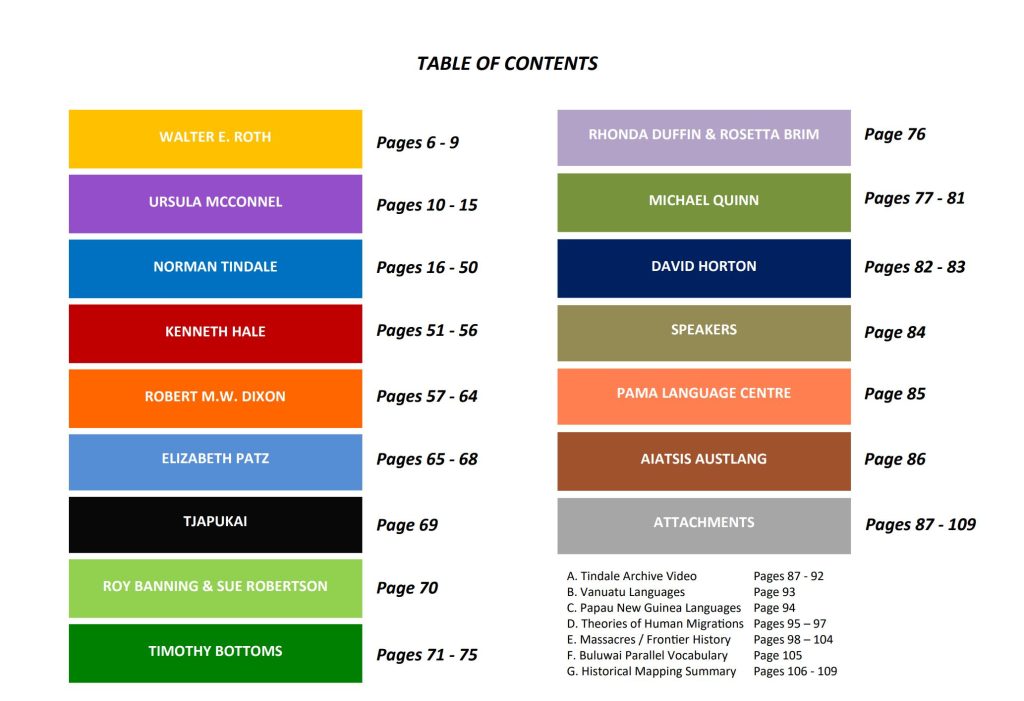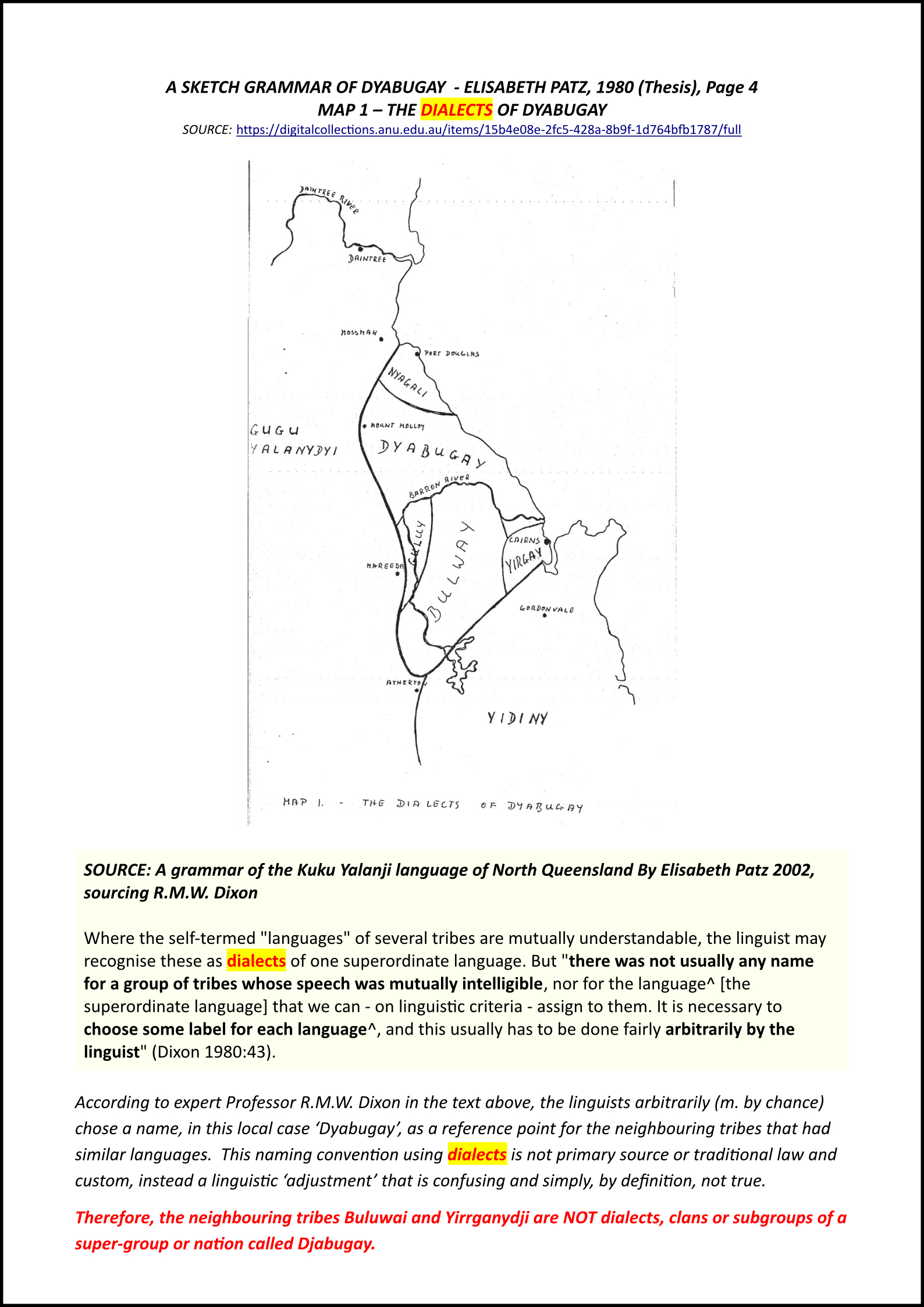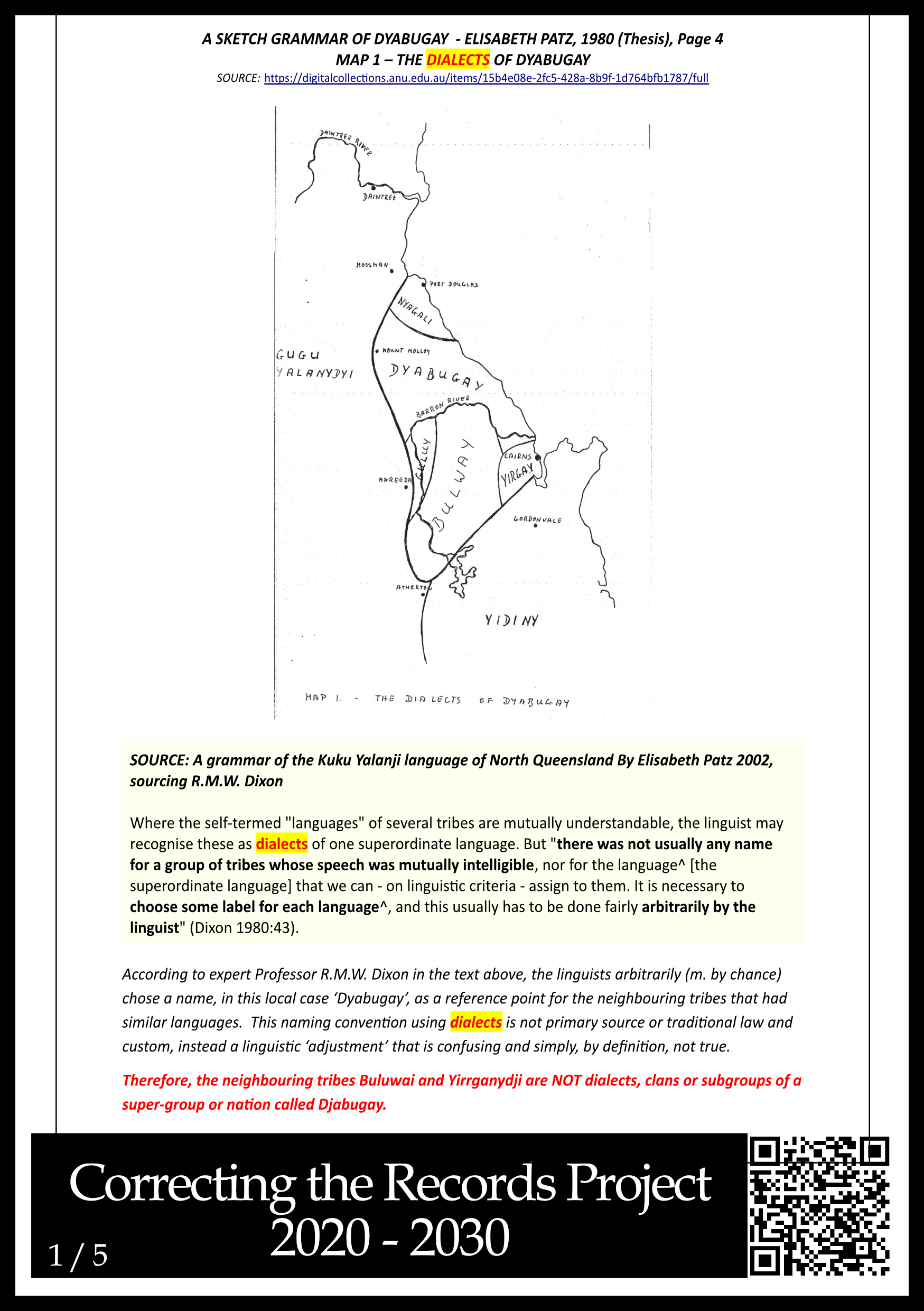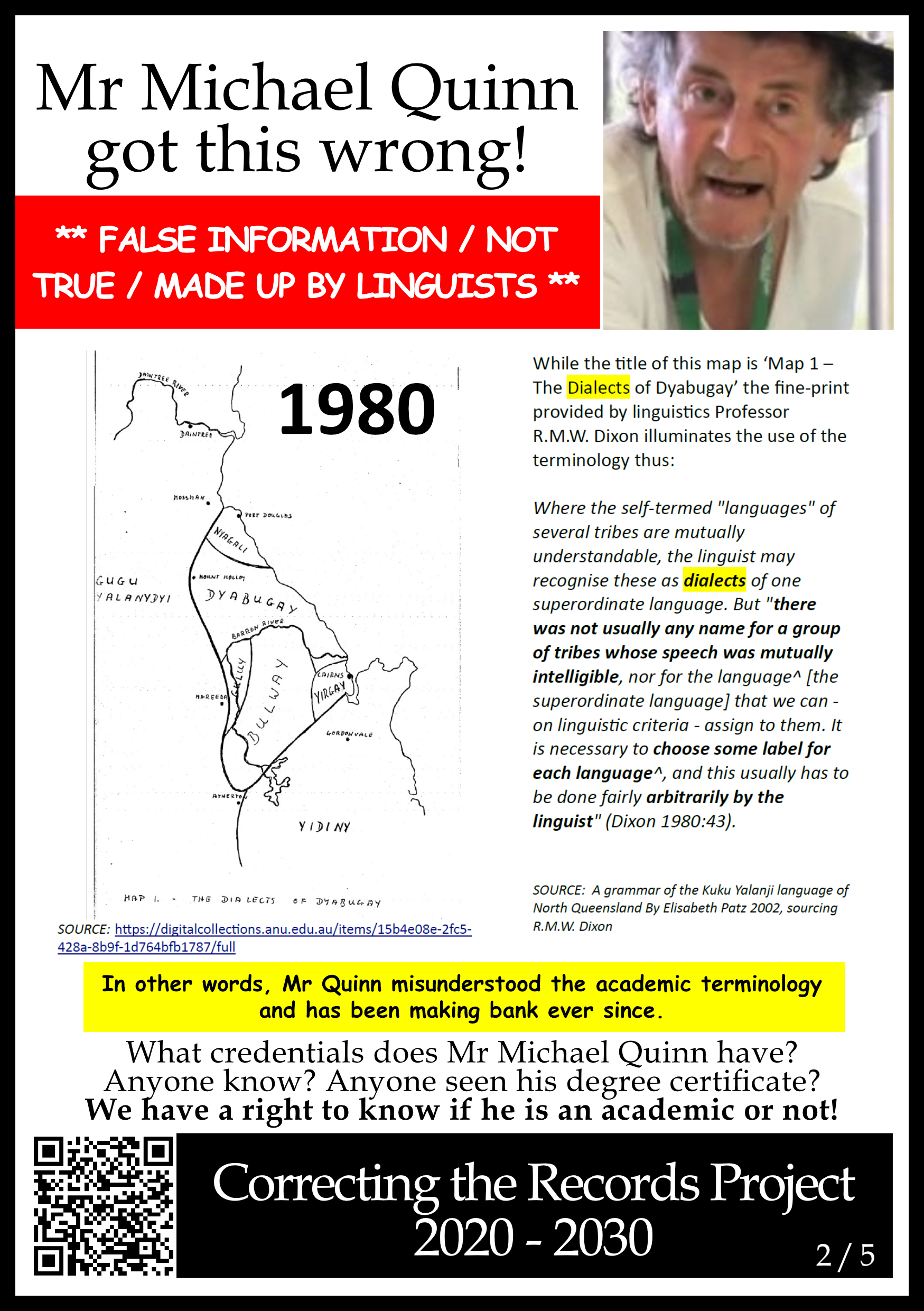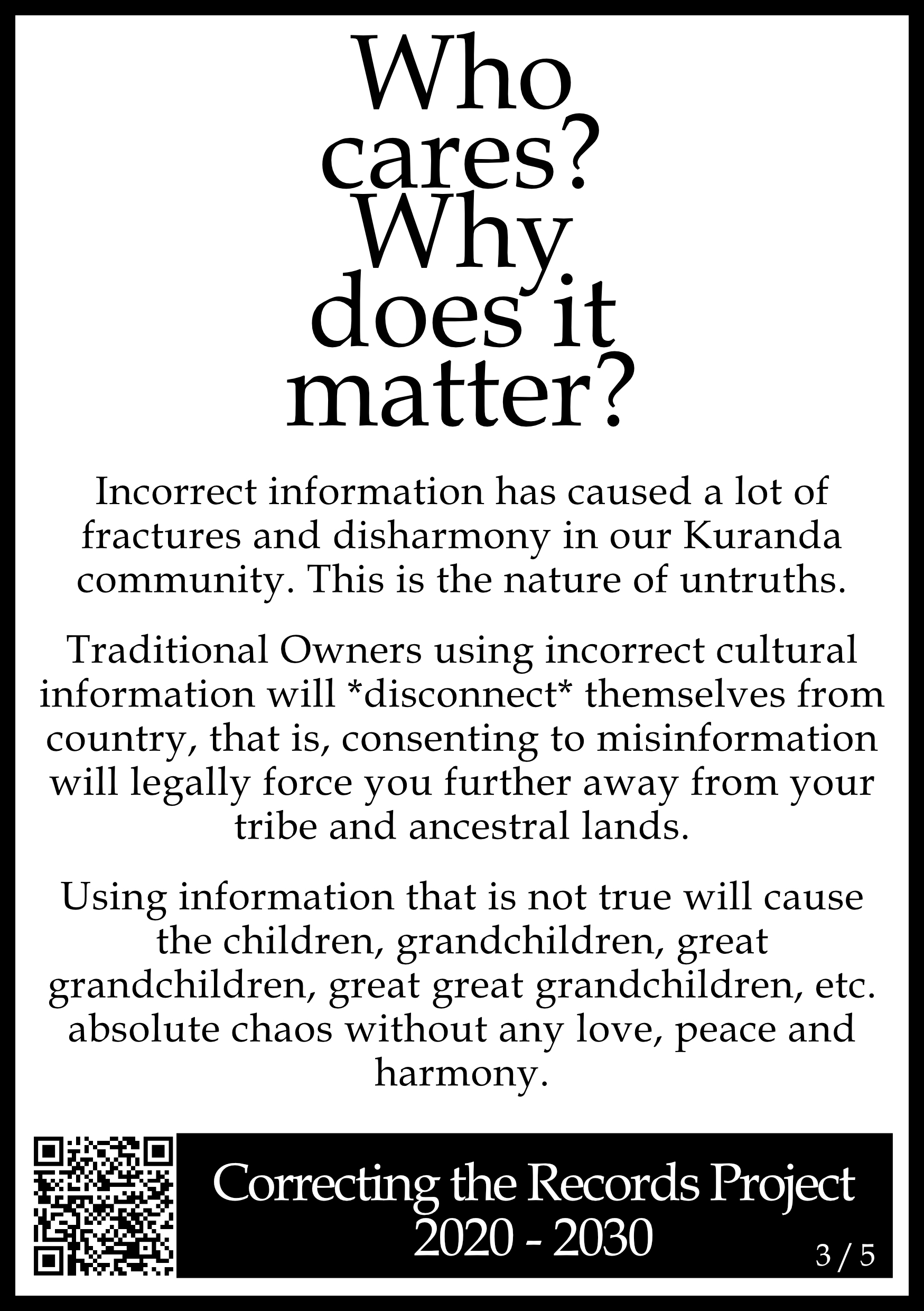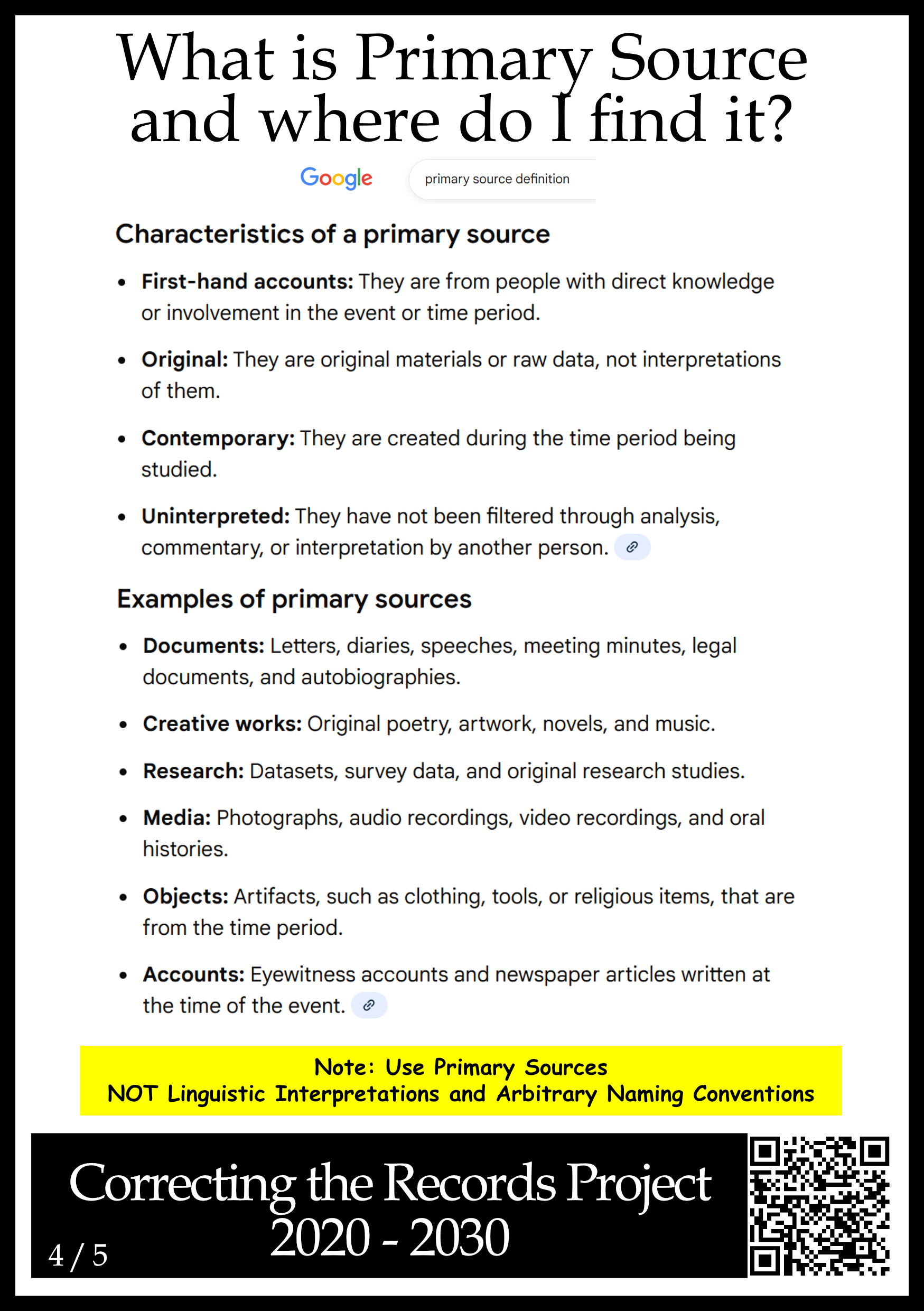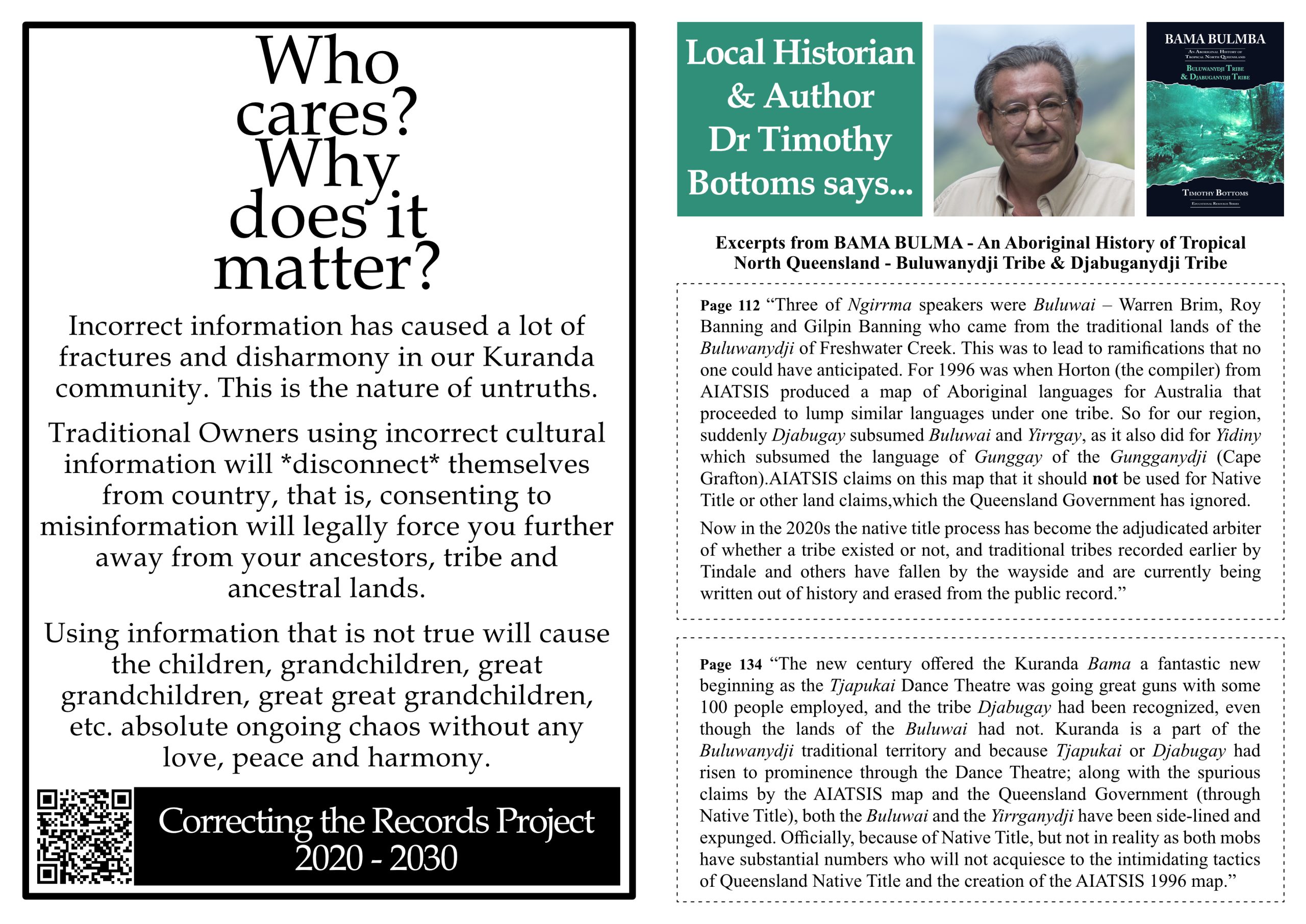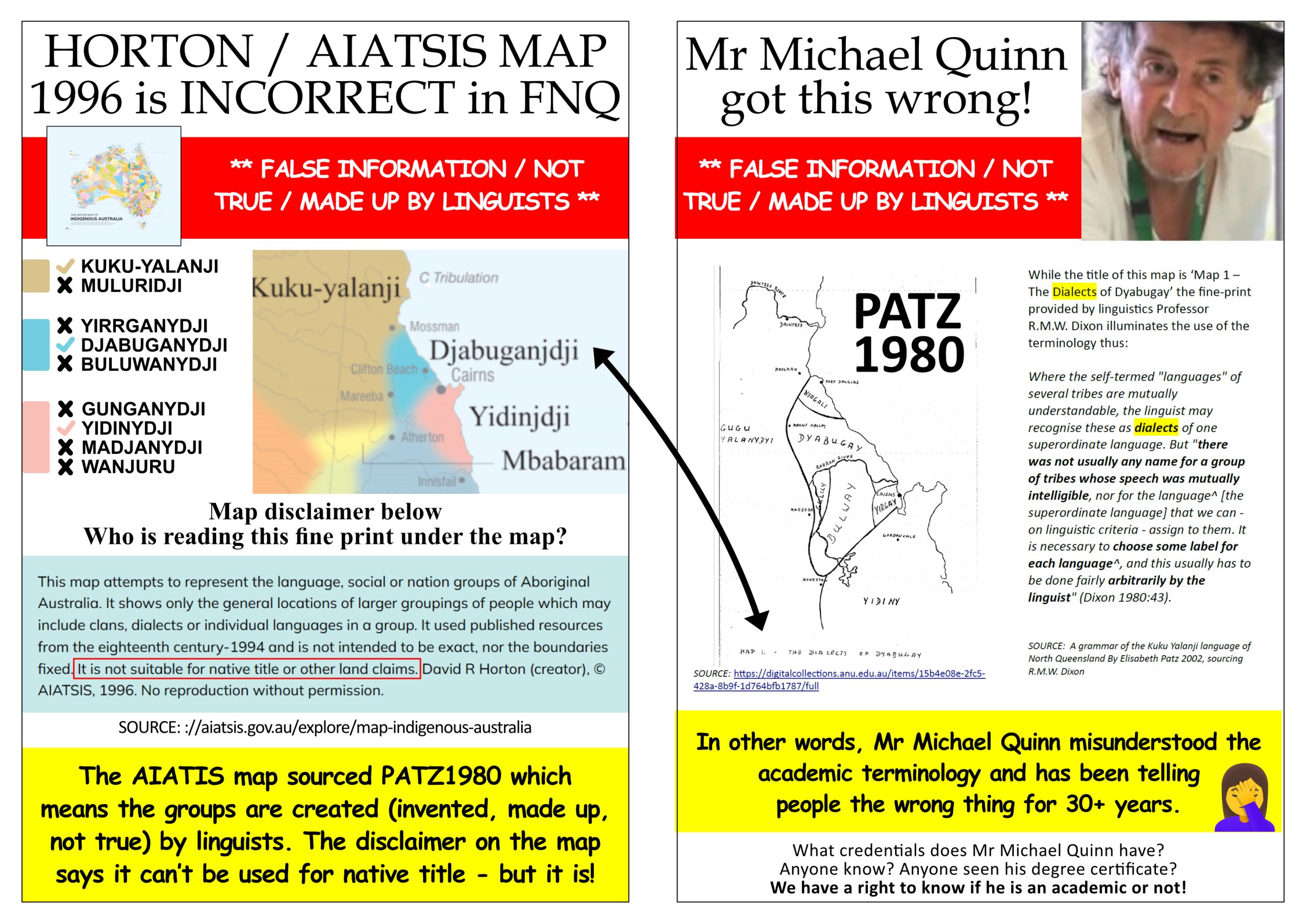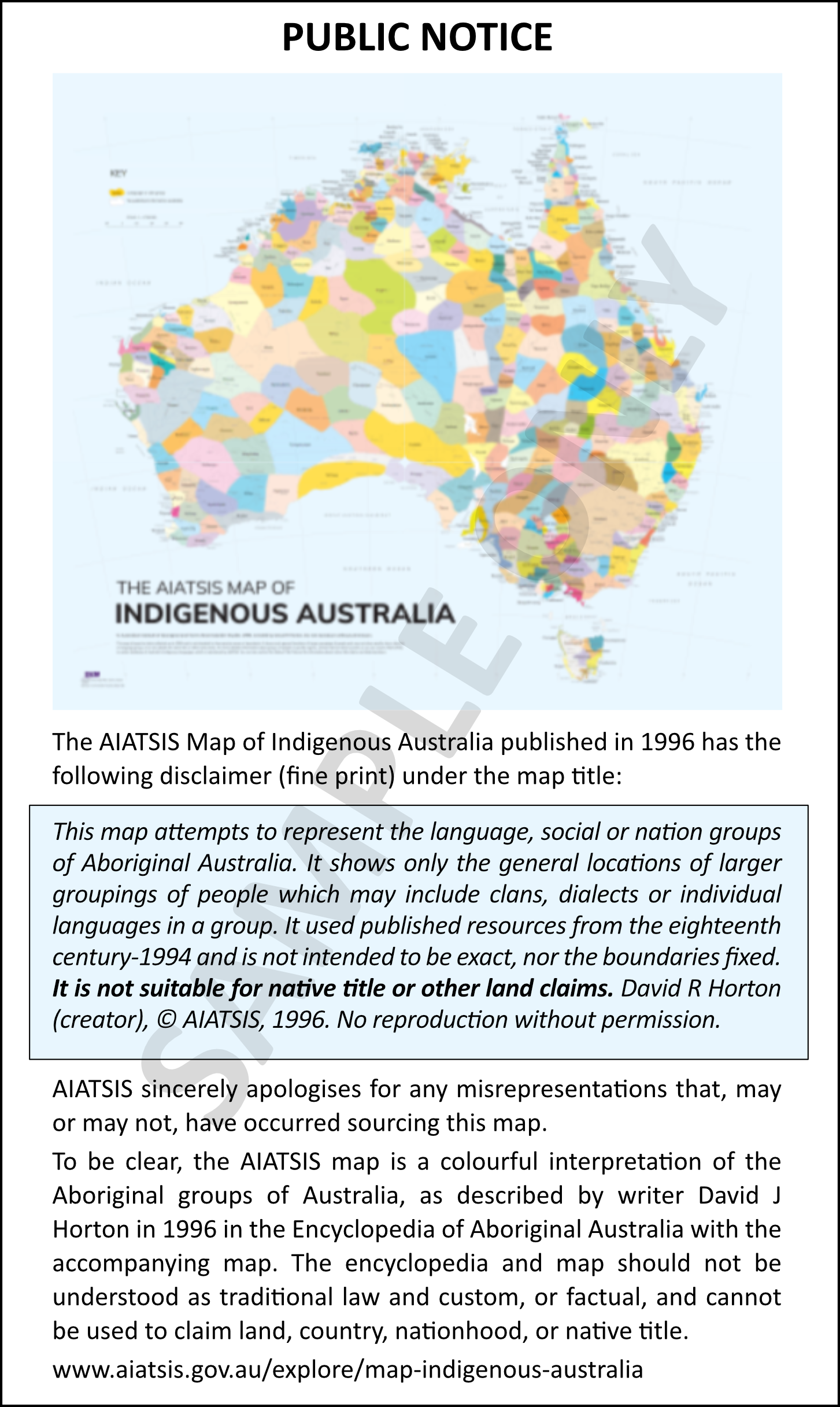Correcting the Records Project 2020 – 2030
This project started in 2016 to research and record historical Aboriginal information about the tribes of the greater Cairns area, including Kuranda.
Unfortunately there has been misinformation over the last 30 years which has exacerbated Aboriginal community issues. This project aims to ‘correct the records’ to avoid future publishing of incorrect information in printed materials and on websites.
Hard copies of the research document sets below are available on loan. Please contact us.

INFOGRAPH EXPLAINER
Aboriginal Groups of the Cairns Area – 2 pages
This page (B) shows the map with “Djabugay Nation” over the entire area. “Djabugay Nation” is deliberately inside quote marks because it is misinformation (an invented term).
PATZ proposed in 1980 that these neighbouring tribes were dialects of Djabugay. PATZ 2002 publication she quotes DIXON to explain (see RED text below) “It is necessary…”. That is, PATZ arbitrarily chose ‘Djabugay’ however, she could have equally chosen ‘Buluwai’ or ‘Yirrgay’ to coin the term to describe language similarities between these neighbouring tribes. PATZ also describes that pre-colonisation these tribes saw themselves with their own languages and did not group themselves according to linguistic dialect theory.
REFERENCE DOCUMENTS (2020 – 2023)
- AIATSIS Forgotten tribes of Far North Queensland (PDF) | JPG
- Letter to AIATSIS 29 OCT 2020 (PDF)
- #CORRECTTHEAIATSISMAP (PDF)
- Letter from Craig Ritchie, CEO, AIATSIS 24 NOV 2020 (PDF)
- Letter to Craig Ritchie, CEO, AIATSIS 10 DEC 2020 (PDF)
- Mona Mona Descendants (PDF) | PNG
- In Brief: Cairns Regional Claim Tribes
- Anthropologists or linguists? Historians or Aboriginal Elders? (PDF)
- Buluwai Tribal Estate taxonomy (PDF)
- Buluwai Tribal Estate language (PDF)
- Tindale Parallel Vocabularies FNQ Rainforest People Study
- Rainforest Aboriginal People Mapping Summary
- Letter Buluwai Indigenous Corporation AIATSIS 20 JAN 2021 (PDF)
- Letter Buluwai Willie Brim HORTON AIATSIS 16 JAN 2023 (PDF)
- Letter Dear Michael Quinn 8 OCT 2023 (PDF)
REFERENCE DOCUMENTS (2025 – 2030)
- Correcting the Records Project 2020-2030 – Request for apology from Kuranda linguists 22 JUL 25
- Correcting the Records Project 2020-2030 – Request for apology from Kuranda linguists – AMENDMENTS 11 AUG 25
- Correcting the Records Project 2020-2030 – Request for expert assistance from Professor RMW Dixon 4 OCT 25
- Correcting the Records Project 2020-2030 – Request for apology from Kuranda linguists – ADDENDUM 7 OCT 25
- Correcting the Records Project 2020-2030 – Letter to Kuranda Organisation Office Bearers – 27 OCT 25 *See audio version below or click here to view on Youtube.
- Correcting the Records Project 2020-2030 – Email to NQLC – 5 NOV 25
REQUESTED CONTENT CHANGES SERIES
- TRACQS
- Tjapukai Dance Theatre
- Kuranda Community Kindergarten
- kuranda.org *Completed
- djabugay.org.au
- Djabugay Native Title Aboriginal Corporation RNTBC
* Note – this is an incomplete list.
THE ACADEMIC CONTEXT MISUNDERSTOOD BY MR MICHAEL QUINN
Click to open larger version or click here to download PDF version
Professor of Linguistics R.M.W. Dixon says
[R.M.W. Dixon, Words of Our Country, St. Lucia, UQP, 1991, pp.6-7.]
To summarize, names like Yirrganydji, Buluwanyji, and Gunganji break down into three components: stem yirr-/bulu-/gung-, then suffix GAY ‘language,’ then nyji ‘having,’ and their literal meaning is people having the Yirrgay, Buluway, and Gunggay, languages respectively. In Wood’s opinion, the linguistically unanalyzable stems and archaic nature of the GAY suffix imply that these are very old names, and form an old and longstable nomenclature.
In other words, the tribe names are very old names and are the names of the languages spoken by each tribe.
Linguist Dr Elizabeth Patz / Professor of Linguistics R.M.W. Dixon says
[A grammar of the Kuku Yalanji language of North Queensland By Elisabeth Patz 2002, sourcing R.M.W. Dixon 1980]
1.1.2 Kuku Yalanji and its dialects
The concept of “own language” as distinct from “other languages” is an important aspect of tribal identity in Australia (as indeed it is for any nation in the world). Thus Aborigines distinguish their own language from that of another tribal group, even if the differences are only slight, sometimes represented by just a few different lexical items. Accordingly, a tribal name is often derived from the language name in Australia, whereas the reverse is seldom encountered (cf. Dixon 1980:33-43).
Where the self-termed “languages” of several tribes are mutually understandable, the linguist may recognise these as dialects of one superordinate language. But “there was not usually any name for a group of tribes whose speech was mutually intelligible, nor for the language^ [the superordinate language] that we can – on linguistic criteria – assign to them. It is necessary to choose some label for each language^, and this usually has to be done fairly arbitrarily by the linguist” (Dixon 1980:43).
In other words, the linguists chose, by chance, a name to represent neighbouring tribes with similiar languages.
Letter to Kuranda Organisation Office Bearers **AUDIO VERSION**
RE: Correcting the Records Project 2020-2030
RE: Discrediting Mr Michael Quinn’s Position, ie. Not legitimate cultural information
RE: Requesting change to dictionary map page – add the linguist’s disclaimer regarding dialects to avoid future misunderstandings
Social Media Educational Series
This series has been created to assist the community to understand what has happened and to recover truthful information as quickly as possible.
Community Handout – A4 landscape folded in half
Print file – A4 landscape folded in half, printing back to back, click here to download PDF
Click on the pages below to see them at a larger size.
Kuranda Organisation Engagements
- 2 Nov 2025, a letter of advice to Kuranda Organisation Office Bearers is sent by mail to the office bearer’s registered addresses, read the letter here
- 10 Nov 2025, the audio version of the letter was uploaded to Youtube for ease of access purposes, click here to watch / listen on Youtube
AIATSIS Letter Request for ‘Public Notice’ Requested for Kuranda, Far North Queensland

